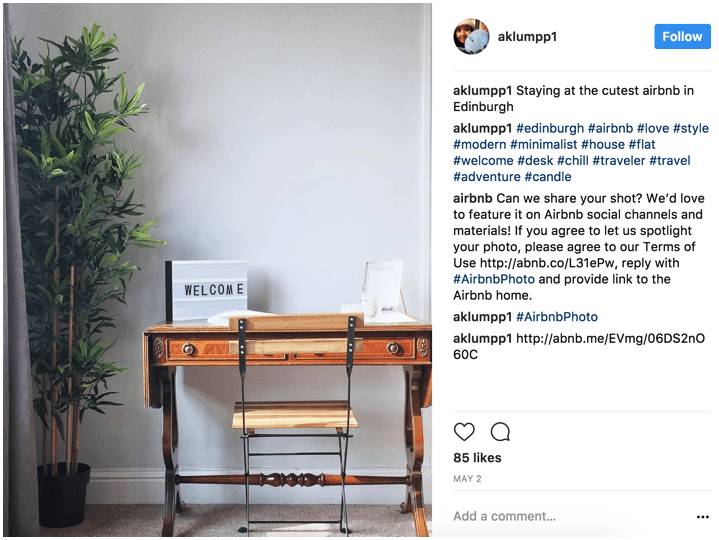How your users' content can boost your results
The best things in life are free. And user-generated content (or UGC) — which costs nothing — is one of the best marketing strategies available to brands, especially on Instagram. While its user base isn’t as large as that of its parent company, Instagram is crushing Facebook in terms of brand engagement.
How would you react if someone you feel a genuine connection with posted about how great his experience with a brand was? You’d likely believe it.
That’s why UGC is more trustworthy, influential, memorable, and, ultimately, effective for brand promotion than many traditional advertising techniques.
Download Paid Member Resource – Social Media Strategy Guide
Understand how to best use social media in your marketing strategy as an individual or as a business.
Access the Social media marketing strategy guide
What Is UGC?
While the name is fairly self-explanatory, here’s a quick primer: If a customer or fan posts a photo or video about your brand, it’s user-generated content.
Let’s say that someone wearing a Herschel Supply Co. backpack posts a picture of himself to Instagram, along with Herschel’s branded hashtag #welltravelled. Other Instagram users can search for that hashtag and engage with the picture by liking it or commenting on it — and Herschel can even repost the picture to its own feed. Similarly, if you were to post a picture to Instagram of a beautiful Airbnb loft you stayed in, with #airbnb added to the post, that’s also user-generated content that other Instagram users can engage with.
Any photo, video, tweet, snap, post, or review that’s shared about a brand can be considered UGC — which is great news for your marketing team.
Why Repurpose UGC?
Brands have a lot to gain by incorporating UGC into their marketing mix — both in terms of building customer loyalty and driving sales. UGC helps you build authentic and trusted relationships with consumers because it allows your audience to see how your products are used in real life.
Based on a recent survey, 76 percent of respondents believe that UGC is more trustworthy than branded advertising. Moreover, 84 percent of those surveyed in another study put as much stock in online reviews as they do in personal recommendations from people they know.
If that’s not enough to convince you, consider this: Engaging with a brand’s UGC makes customers 97 percent more likely to purchase than those who don’t interact with it, and this engagement boosts the brand’s conversion rates by a staggering 78 percent. That’s a pretty clear indication of just how valuable UGC can be for your brand!
Consequently, user-generated content can save you money. Every post or endorsement that’s made by one of your customers is akin to free marketing — especially among Millennial consumers, who trust user-generated media 50 percent more than any other type.
In effect, by repurposing UGC, you benefit from an army of brand ambassadors who do the work for you, providing future customers with real-life testimonials and compelling imagery. If someone is searching for specific details about a certain product, for instance, UGC can even serve as a free (and candid) type of outsourced customer service.
Is Repurposing UGC Legal?
Using another person’s social media post in your marketing efforts does raise some legal and ethical questions. Before you invest in UGC for your marketing efforts, there are some finer points you need to address.
People who use your branded hashtag may be implying that they give permission for your brand to repurpose their content (with credit), but your bedrock principle should be that all UGC is, by default, copyrighted by the owner or creator of that content.
I reached out to the lawyers at Gowling WLG, an international law firm, to ask for more technical advice on these legal matters. They advise confirming that the original poster of the content exclusively owns that content, and then getting that poster’s permission to repurpose it. You may also need the permission of any person depicted in a photograph.
That means you’re technically required to ask for permission for use. But what exactly does that mean? Does getting someone to reply “Yes” when you ask, “Can I repost this photo?” count as permission? Do you need to send a link to an agreement and have the person sign it? Can you get an agreement from certain users to repost any of their content?
I’ll use the Airbnb example again to illustrate UGC best practices. Airbnb reaches out to Instagram users who tag @Airbnb or hashtag #airbnb in their posts, requesting permission to repost these photos in its own feed. The company leaves a comment asking users to go to a link where they can read and agree to Airbnb’s terms of use for UGC. Users are asked to reply with #AirbnbPhoto to confirm and provide the link to the Airbnb home featured.

In summary, assume that all content is copyrighted, check the terms on each social network, and get permission from the original post creators. They should have no doubts about how you intend to use their content. Playing fast and loose with permissions may jeopardize your brand’s reputation in the long run. You need to ensure that your intentions don’t contradict the creators’ reasons for posting it to begin with.
Generating UGC
Of course, these questions about permission assume that you already have a system in place for curating user-generated content. If not, the first step is to create a branded hashtag and encourage your followers to post with it. By inviting your followers to post with your hashtag, you’re offering them a chance to stand in the spotlight — especially if you repost UGC on your own feed. Perhaps that’s why 65 percent of people will grant permission to use their photos within 24 hours.
Another good way to generate more UGC is to hold a contest or sweepstakes that challenges people to use your branded hashtag on a photo or post in exchange for entry into a prize drawing. Contests capitalize not only on your customers’ interest in your product, but also on their competitive drive.
Japanese retailer MUJI, for example, found great success with a contest it launched to encourage its followers on social media to post photos of artwork they had created with MUJI pens. Using the hashtag #mujipenart, MUJI saw more than 2,500 people enter the contest, greatly increased its social reach, and created an entirely UGC-driven campaign for the cost of a few special awards and prizes.

Any buzz generated by a contest will outweigh the cost of the prize, and in the process, you’ll build up a bank of user images and comments that you can draw on in the future
If contests and invitations fall short of meeting your goals, you can always turn to the power of influencer marketing. What better way to bring attention to your brand than to have a celebrity, an industry leader, or a popular media figure recognize your products in a social media post?
Instagram influencers with a large following can create content on behalf of your brand, allowing you to gain credibility and have impactful conversations with your customers. Influencers can give a shout-out to your brand or a specific product in a variety of ways, from simply using your hashtag to directly expressing the reasons they love the product. The goal of working with an influencer is to move your consumers to action by building brand trust that you may not be able to acquire easily or quickly on your own.
Succeeding With UGC
These days, repurposing UGC is considered standard, not standout. But there are a few things you can do to make sure your UGC efforts are actually furthering your business.
1. Publish UGC alongside your product.
Aligning UGC with your own marketing materials shows people how they can use it in their everyday lives, which amplifies the overall impact.
Sonos has mastered this by embedding Instagrammed UGC as part of the buying process on its website. On a Sonos product page, you’ll find not only marketing material and product specs, but also customer photos depicting how they use the brand’s speakers in their homes. These images seamlessly invite new customers to imagine how a Sonos product could improve their own lives.

2. Supplement emails and promotional materials with UGC.
When you sign up for promotional emails from shorts brand Chubbies, you receive newsletters bursting with UGC. Instead of promoting its products with models, the company uses photos of real, happy customers, which lends a sense of authenticity to the brand. In this way, Chubbies leverages its UGC to promote customer satisfaction with its products.
How does Chubbies manage to collect so much UGC? The brand actively encourages its customers to share their personal experiences with Chubbies on social media. By integrating UGC into all of its social accounts, the brand has inspired more than 331,000 people to follow Chubbies on Instagram and more than 1.6 million to do so on Facebook.
3. Build a branded hashtag.
A branded hashtag should be unique to your business. It can be as simple as your company name, your tagline, or the name of one of your products or campaigns, like Coca-Cola’s #shareacoke campaign, which resulted in a more than 2 percent increase in sales. Or it can be a hashtag that has nothing to do with your brand name but has everything to do with your brand identity. For instance, Always’ well-known “Like a Girl” campaign is meant to inspire confidence in young women and turn the common expression upside down by showcasing the stories of women doing amazing things #likeagirl.

A branded hashtag can help start a conversation with those unfamiliar with your brand, build or re-establish brand loyalty among current customers, and lead to the generation of more UGC. A branded hashtag with a good hook can spark a cascade of content from your best customers and help you reach previously untouchable — or even unknown — markets.
With these tips and some advanced planning, content generated by users can be an outright gift to your brand in the form of organic, user-generated marketing campaigns.

Thanks to Matt Smith for sharing their advice and opinions in this post.
Matt Smith is the founder of
Later, the No. 1 Instagram marketing platform to visually plan and schedule Instagram posts. Prior to Later, Matt founded several startups, including Thinkific, an online course platform helping thousands of people build businesses online.








 Thanks to Matt Smith for sharing their advice and opinions in this post.
Thanks to Matt Smith for sharing their advice and opinions in this post. 


